Amazon Prime Student 6-month Trial

Try Amazon Fresh
 P-47 Thunderbolt: Aviation Darwinism
Chapter Three:
When one studies the design philosophy of the P-47, one cannot help
but realize that Major Seversky’s vision of a true high performance
fighter had been fulfilled. Since 1939 Seversky had stated that any
new fighter designs would need to be bigger, faster and higher flying.
The USAAF, already unhappy with Seversky for late deliveries and
using Air Corps money to fund racing versions of the P-35, not only
ignored the Major, they spared no effort to discredit him. Yet,
within a few months, circumstances had evolved, largely as a result
of war in Europe. As a result, the lightweight fighter concept, liked
very much by Kartveli, was a philosophy now bankrupt. Finally out
from Seversky’s shadow, Kartveli had thrown himself and his engineering
staff into the XP-47 and XP-47A designs. It must have been a terrible
shock to find out that all their work was as good as for nothing. A
more sobering realization for Kartveli was that the Major had been
correct all along.
P-47 Thunderbolt: Aviation Darwinism
Chapter Three:
When one studies the design philosophy of the P-47, one cannot help
but realize that Major Seversky’s vision of a true high performance
fighter had been fulfilled. Since 1939 Seversky had stated that any
new fighter designs would need to be bigger, faster and higher flying.
The USAAF, already unhappy with Seversky for late deliveries and
using Air Corps money to fund racing versions of the P-35, not only
ignored the Major, they spared no effort to discredit him. Yet,
within a few months, circumstances had evolved, largely as a result
of war in Europe. As a result, the lightweight fighter concept, liked
very much by Kartveli, was a philosophy now bankrupt. Finally out
from Seversky’s shadow, Kartveli had thrown himself and his engineering
staff into the XP-47 and XP-47A designs. It must have been a terrible
shock to find out that all their work was as good as for nothing. A
more sobering realization for Kartveli was that the Major had been
correct all along.
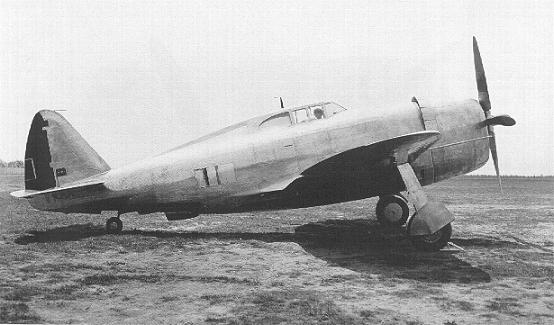 The XP-47B on roll out day, May 4th, 1941.
The XP-47B on roll out day, May 4th, 1941.
Unlike the XP-44 design, no mock-up of the XP-47B was requested by
the USAAC, nor was any money allocated for one. The new fighter
could not hope to go efficiently from the drafting table to the
factory floor. Therefore, a mock-up was built at company expense.
In early production P-47’s the vast majority of the cockpit section
was taken straight from the P-43. However, for some unknown reason,
the mock-up, prototype and the first three production P-47B aircraft
were built with an unusual and difficult to use fixed canopy equipped
with a forward opening door not greatly unlike the P-39 and early
Hawker Typhoon. Fortunately, whoever selected this oddball canopy
design was eventually over-ruled and the P-43 arrangement was implemented
after the fourth aircraft.
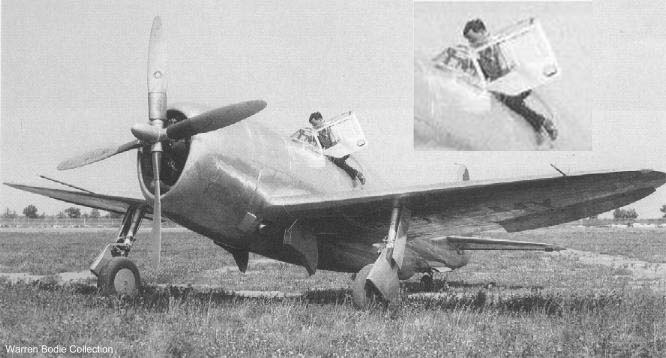 The unusual cockpit door of the XP-47B is clearly seen in the inset.
The unusual cockpit door of the XP-47B is clearly seen in the inset.
Note that the vent window is open.
Work on the first flyable XP-47B moved along at a brisk pace and the
“eggheads” from Wright Field were invited to inspect the new fighter.
Generally, they were happy with what they saw. One problem discovered
was that measured fuel capacity was somewhat less than the specification
had called for. Only 298 gallons could be squeezed into the tanks, 17
gallons less than the requirement. The weight of the plane was
greater than the specification requirements as well. Republic’s
design team had built immense strength into the design. This pushed
the weight up to just over 12,500 lbs, or about 900 lbs over the
required limit. The engineers from Wright Field indicated that these
issues could be overlooked if the fighter performed to specification.
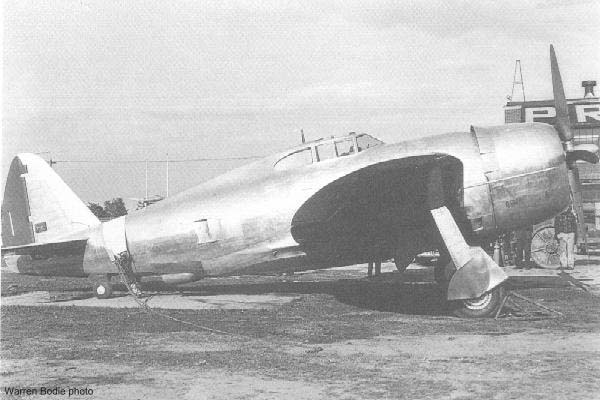 Tied down and chocked, the prototype XP-47B is readied for
Tied down and chocked, the prototype XP-47B is readied for
a maximum power run-up the day before its first flight.
Finally, on May 6th, 1941, the big fighter was ready for its first
flight. With test pilot Lowery Brabham at the controls, the XP-47B
roared off Republic’s wet sod field, getting airborne after a scant
2,500 feet of takeoff roll. Brabham was instantly pleased with the
fighter's handling and power. Nonetheless, as he climbed and the
ambient pressure dropped, smoke began to fill the cockpit. Unable
to open the cockpit door in flight, Brabham opened a small vent
window. That, however, was a mistake. The velocity of the air rushing
past the vent served only to lower the relative pressure across the
vent, resulting in even more smoke being drawn into the cockpit.
Concerned, but not panicked, Brabham decided to get the ship down
quickly. Thoughts of losing the prototype on its maiden flight were
all the motivation he needed. Remembering how soft the wet sod had
been at Farmingdale, Brabham headed for the paved runways of the
nearby Air Corps facility at Mitchel Field.
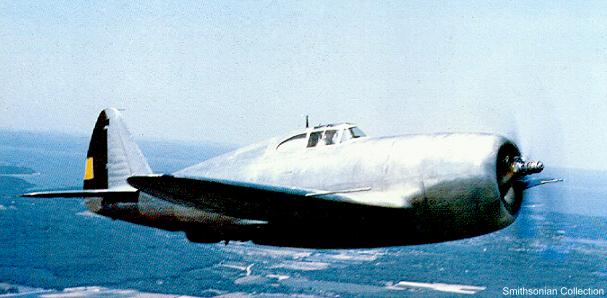 The XP-47B was photographed in color several times during its early test flights.
The XP-47B was photographed in color several times during its early test flights.
The first landing of the XP-47B was uneventful. The flaps, brakes and
landing gear worked as advertised and Brabham taxied in towards the
Air Corps hangers. His arrival, however, was indeed an event. Army
and Air Corp personnel poured out to greet the big fighter as it rolled
to a stop with its huge propeller winding down. Nothing like the XP-47B
had ever been seen before. Senior officers quickly cleared the field
and the new fighter was quickly rolled into a hanger and the doors
shut.
It took but a quick inspection to determine what had caused the smoke
in the cockpit. Oil in the turbo-supercharger ducting was the culprit.
Prior to taking off, Brabham had performed an extensive run-up on the
concrete ramp. He checked, double checked and even triple checked every
engine instrument. He performed several mag checks and made sure the
engine was at optimal operating temperature. During this time, oil
had been accumulating in the ducting leading to the turbo-supercharger
installed behind the cockpit. The ducting ran just below the cockpit.
The engine is fitted with a pair of wastegates that dump excess boost
and thereby regulate manifold pressure. The wastegates are in turn,
controlled by a governor. At low altitudes the governor monitors and
is itself controlled by maximum manifold pressure. At altitude, the
governor responds to turbine speed. As the XP-47B climbed out, the
governor closed the wastegates. The oil in the ducts was rapidly heated
and began to give off smoke.
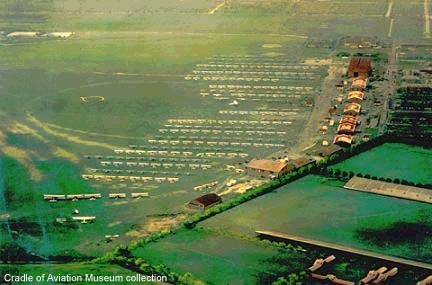 Mitchel Field as it appeared in 1931. The photo has been colorized.
Mitchel Field as it appeared in 1931. The photo has been colorized.
The XP-47B would remain at Mitchel Field for about a month as
modifications were made to eliminate the possibility of oil smoke entering into the cockpit.
Some additional, but minor changes were implemented and surprisingly, no national
insignia was yet applied to the wings and fuselage. The XP-47B was never
delivered to Wright Field, as had been the practice for all new designs
for many years. It was tested in the skies over Long Island. Having
been assigned to Republic in order to expedite any required changes,
it would remain in the hands of its manufacturer until its inadvertent
loss in 1942.
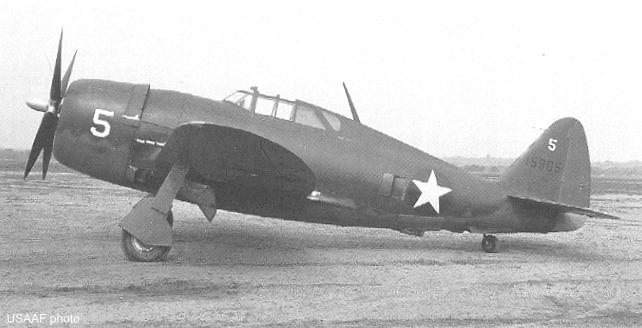 The first P-47B off of the line was flown to
Wright Field for testing. The first production
The first P-47B off of the line was flown to
Wright Field for testing. The first production
aircraft was actually the fifth
airframe completed, and the first with a sliding canopy.
In the meantime, The XP-47B revealed that it was everything that it
was hoped it would be. It attained a corrected true airspeed of 412
mph at 25,800 ft. The big Pratt & Whitney R-2800-17 proved to be
reliable and actually produced the horsepower that Pratt & Whitney
had claimed it would. The Curtiss Electric propeller worked well at
getting all 1,960 hp harnessed for thrust. There were some problems
still to be worked out. The turbo-supercharger installation increased
the risk of a fire (this is exactly what caused the loss of the
prototype nearly a year later). The cockpit canopy needed to be
rethought. Indeed, there would be a myriad of minor changes that
were to be incorporated into the first production aircraft. But,
the die was cast. Alexander de Seversky had been vindicated. His
theories had passed the test of reality and the fate of many a
German and Japanese airman had been sealed.
Go to Chapter Four
Return to the Planes and Pilots of WWII
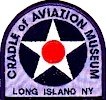 Return to the Cradle of Aviation Museum
Return to the Cradle of Aviation Museum

Unless otherwise indicated, all articles Copyright © Jordan Publishing Inc. 1998/1999.
Reproduction for distribution, or posting to a public forum without express
written
permission is a violation of applicable copyright law. The Cradle of Aviation
Museum patch is the property of the Cradle of Aviation Museum.
Reproduction for distribution, or posting to a public forum without the written permission
of Jordan Publishing Inc. is prohibited.










